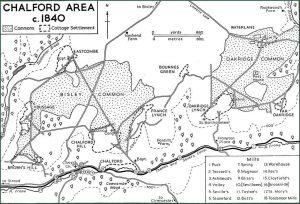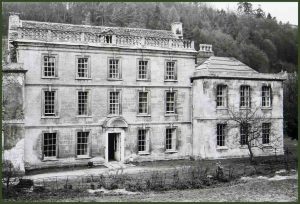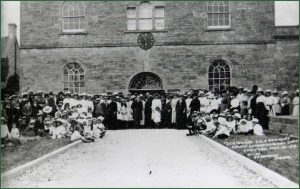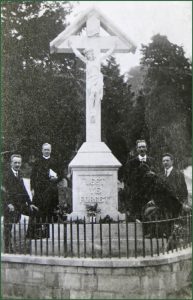Chalford Parish is a civil parish formed in 1894, comprising the villages of Chalford, Chalford Hill, Brownshill, Bussage and France Lynch. At this time the total population was around 2,000. The larger settlements were down in Chalford Vale, where the mills and factories were located. The other villages were dispersed across the hillsides and round the substantial open reaches of Bisley Common, which stretched from the corner of Brownshill in the west over to the crossroads in France Lynch and then all the way to Bisley.

Earliest times
This area has been settled in some way for over 5,000 years. Stone Age flints have been found, and there are known sites of many long and round barrows nearby (chiefly Money Tump, a bowl barrow or funeral monument which is sited near Nash End Farm just off the Bisley – Eastcombe road). There was a Roman Villa nearby at Lilyhorn. Several place names link the area to its Saxon and Danish ancestry.
From Anglo Saxon times most of the current parish was in the ‘Tything of Chalford’ – part of Bisley Hundred – and Bisley would have been the centre for administration, the church, the manor court, the workhouse and so on. However, a small stretch of land south of the River Frome was part of the Minchinhampton Tything in the hundred of Longtree. Much of the land on the hillsides was wooded, with open tracts of land on the hilltops – notably Bisley Common, used for grazing animals.
The first documentation of Chalford as an entity was the grant of lands at Chalford by the Mortimer family (who held the Bisley Manor between 1227 and 1246) to William “son of Hugh of Chalford”. The Chalford estate was later sold to Richard Fox, Bishop of Winchester and he granted Chalford to Corpus Christi College, Oxford in 1523. Corpus Christi held Chalford until 1858 and much local history is held in the Corpus Christi archives.
Rise and fall of the woollen era
The Domesday Book records 5 mills in Bisley and these were probably in Chalford. From medieval times, clothiers began to build more fulling mills along the River Frome and the area became important in the woollen industry. There was easy access to local supplies of wool, fuller’s earth, teasels, dyestuffs and waterpower. By the 17th century, home-based weaving became a major source of employment. As the mills became profitable larger houses were built for their owners and managers along the valley floor.
With prosperity came increasing numbers of weavers and mill workers who could not be accommodated within the Chalford valley. From the late sixteenth century until the time of the decline of the Chalford cloth industry in the late eighteenth century, cloth workers migrated up the northern side of the valley and built stone cottages on land much of which was “stolen” from Bisley Common. These developments included the villages of Chalford Lynch (now Chalford Hill), France Lynch, Bussage and Brownshill.

During the 17th, 18th and 19th century the wool trade hit a series of obstacles, and profitability fluctuated. On the positive side, the opening in 1789 of the Thames and Severn canal, linking the Stroudwater navigation and the River Thames, provided cheaper transport of goods to and from the mills along the Golden Valley, and by 1815 the London road (now the A419) opened, linking Chalford to both Stroud and the Minchinhampton-Cirencester thoroughfare. Only 40 years later, in 1845 the Great Western Railway line from Swindon to Gloucester was completed – Chalford station opened in 1897 and there was a ‘halt’ at St Mary’s Mill.
However, there were serious economic problems facing the mills, resulting in poverty and unrest for the weavers. There were mill closures, strikes and even an occasion when the army was called into Chalford. As the 19th century progressed, such was the extent of unemployment in Bisley that the Parish paid for families to go by ship to Australia to start a new life. Others migrated to Shropshire and West Yorkshire. Soon afterwards, industrialised processes were introduced for all stages of cloth production, and many of the local mill buildings were rebuilt or extended. In due course steam power was used to supplement or even replace waterpower, with steam engines manufactured at the Phoenix Ironworks in Thrupp led by the Ferabee family.
New industry and the parish comes into being
The decline in the wool trade locally was accelerated by a general depression, competition with cloth produced elsewhere and by war. So by the time the Parish of Chalford came into being in 1894, there was little left in the way of cloth making – just a few mills in the flock and shoddy business. Gradually other enterprises started in the former mill buildings: from corn mills, to silk mills, to stick making, to pin-making and bone factories, employing the majority of inhabitants. Other people would have worked in trades, shops, pubs and on neighbouring farms.
The mid-late 19th century also brought an era of public building, with extensions to Christ Church in 1841, and the building of St Michael and all Angels in Bussage (1846) and St John the Baptist Church in France Lynch (1857). The non-conformists had for many years been meeting at the Old Vestry in France Lynch, but in 1818 France Congregational Church opened in Randalls Green. The Baptists built a chapel on Coppice Hill, completed in 1874. The Wesleyan Methodists built the Chalford Ebenezer Chapel with a schoolroom on Marle Hill in 1859, which later merged with the Primitive Methodist Chapel on Midway, Chalford Hill (built in 1820).

Whilst there had been smaller local ‘dame’ schools, and some children would have walked to school in Bisley, it was not until the mid 19th century that the bigger church-run (national) schools opened, making education more widely available. Many churches already ran day schools, but new premises were built in Bussage (1848), Chalford Christ Church (1842), and France Lynch (1847). The non-conformists had a schoolroom in ‘The Old Vestry’ in France Lynch and later a schoolroom was added to the Congregational Chapel in Chalford Hill. In 1874 this moved into new premises as ‘The British School’, which came under the control of the local authority in 1902 as Chalford Hill School.
In 1869 legislation was passed for the enclosure of Bisley Common. Middle Hill Farm and Manor Farm were created, along with allotment sites, burial grounds and the France Lynch and Bussage Pleasure Grounds. However this brought an end to the villagers’ rights to graze stock, including the donkeys that were crucial to transport up and down the hill. This caused much anger, attacks on the stone walls, and a claim that the squire had ‘stolen the donkeys’ dinner’.

The Great War and afterwards
By the outbreak of the Great War in 1914, the parish had become a thriving, mainly industrial community. In addition to employment in the local factories, people could now travel to work in Stroud and even further afield by train, and there were daily horse-driven ‘carriers’ to and from Stroud.
As hundreds of local men enlisted, or were later conscripted into the army, many local women took their places in local factories or on the land. Both men and women were employed to help build the Minchinhampton Aerodrome (now Aston Down). Those who remained in the villages organised knitting copious quantities of garments to be sent with food and cigarettes to troops at the front.
World War Two and afterwards
During WWII the parish again adapted to a state of war. Although mercifully fewer servicemen lost their lives, daily life was considerably disrupted and massive effort was put into civil defence.
Following the war, most of the factories in the former mills closed and were replaced by smaller scale enterprises. One or two larger concerns have developed, however, including Chalford Building Supplies and Pangolin Foundry, both on the site of the former Bliss Mills. In 1964 the station at Chalford closed.
In the late 1970’s building commenced on the Manor Farm, one of the farms created following the enclosure of Bisley Common. Over a period of some twenty years a significant estate was created, constructed by a number of builders, including Robert Hitchens Ltd. In addition, Bussage School was given a new home on The Ridgeway, shops were built, and a secondary school built just over the parish boundary in Eastcombe (initially Manor School, later Thomas Keble).
Recent years
The parish now has its own Parish Centre, in Geralds Way. Not long ago flooding from the River Frome was a problem – quite extensively along Chalford Vale in 2012, and more locally at the foot of Hyde Hill in 2016.
By the year 2015 the population of the parish had reached 6,215 thus increasing by a factor of three since the civil parish came into being in 1894 when the population was around 2,000.
